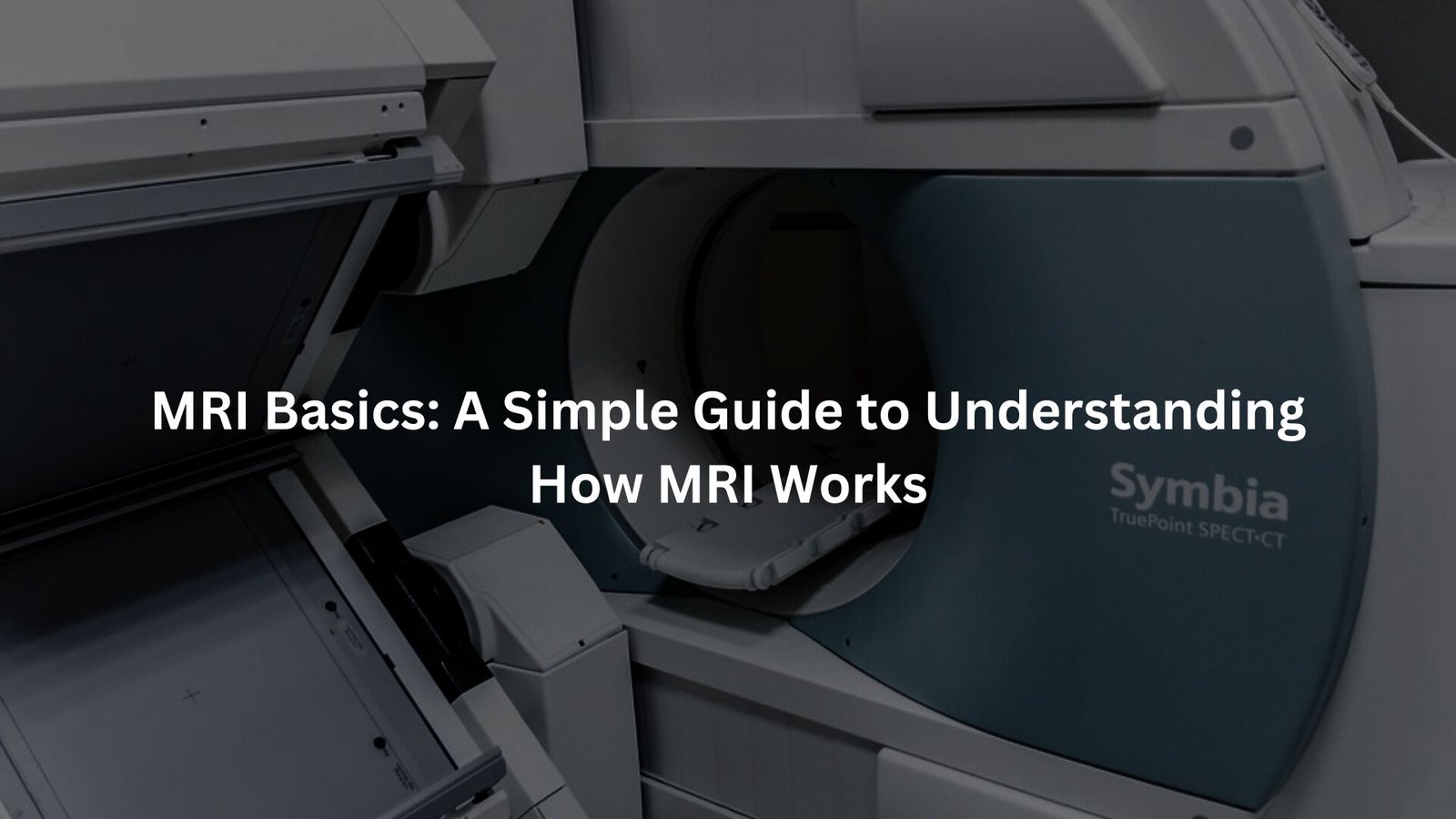Learn the fundamentals of MRI technology, how it operates, and why it’s essential for accurate medical imaging.
MRI (Magnetic Resonance Imaging) is a powerful diagnostic tool that captures detailed images of the inside of the body without using ionising radiation.
By leveraging magnetic fields and radiofrequency pulses, MRI provides critical insights into soft tissue conditions, brain disorders, joint injuries, and more. This guide will explain how MRI works, its various applications, and why it’s so important in modern medicine.
Key Takeaway
- MRI uses magnetic fields and radiofrequency pulses to create detailed, non-invasive images of the body.
- MRI is vital for diagnosing a range of conditions, from brain disorders to joint injuries and cancer.
- MRI offers major advantages over other imaging methods, including no radiation exposure and superior soft tissue imaging.
MRI Basics
Magnetic Resonance Imaging (MRI) is a non-invasive diagnostic tool that enables medical professionals to capture highly detailed images of the inside of the body. Unlike X-rays or CT scans, MRI uses powerful magnets and radio waves, rather than radiation, making it a safer option for repeated use.
MRI is particularly effective in producing clear images of soft tissues, such as the brain, muscles, and organs, areas where other imaging techniques may not provide the same level of detail. Its lack of ionising radiation adds an extra layer of safety, especially for patients who require regular scans.
Key benefits of MRI include:
- No ionising radiation, making it safer for repeated scans.
- Exceptional image quality, particularly for soft tissues.
- Highly effective for diagnosing complex conditions, such as brain disorders, musculoskeletal injuries, and heart disease.
With its ability to capture intricate details, MRI has become an essential tool in modern medicine, ensuring accurate diagnoses and informed treatment plans. (1)
How MRI Works
MRI works on a fascinating principle: the behaviour of hydrogen protons when exposed to a magnetic field. Since the human body is mostly water, and water consists of hydrogen and oxygen atoms, this makes MRI a perfect fit. When a person is placed inside the MRI machine, a strong magnet aligns the hydrogen protons in the body.
Radiofrequency pulses are then sent into the body, momentarily disturbing the protons’ alignment. Once the pulses stop, the protons return to their original position, releasing energy in the process. This energy is captured by the MRI scanner.
The amount of energy released differs between tissues:
- Soft tissues, like muscles and the brain, emit weaker signals.
- Denser tissues, such as bones, release stronger signals.
These signals are processed by a computer to generate a detailed image, enabling doctors to accurately diagnose and assess the patient’s condition. (2)
MRI Imaging Modalities
MRI can produce different types of images, each serving specific diagnostic purposes. The two main types of images are T1-weighted and T2-weighted images, both of which highlight different aspects of tissue.
- T1-weighted images: These images are ideal for visualising the anatomy of the body. They offer high contrast between fat and water, making them helpful for examining the structure of organs and tissues.
- T2-weighted images: These images highlight differences in the water content of tissues. They are particularly useful for detecting abnormalities in tissues that may be swollen or contain excess fluid, such as tumours or inflammation.
There are also specialised MRI techniques, such as:
- Magnetic Resonance Angiography (MRA): This modality focuses on imaging blood vessels, helping doctors diagnose issues like blockages or aneurysms.
- Diffusion-Weighted Imaging (DWI): DWI is highly sensitive to the movement of water molecules in tissues, which can be important for detecting conditions like stroke or cancer.
Each of these imaging modalities offers a unique way to visualise internal body structures, allowing doctors to better understand and diagnose medical conditions.
MRI Image Quality
The quality of an MRI image depends on several factors, including signal intensity, spatial resolution, and temporal resolution.
- Signal intensity: This refers to the strength of the signal emitted by the tissue, which affects the brightness of the image. The stronger the signal, the clearer and more detailed the image will be.
- Spatial resolution: Spatial resolution determines how much detail can be captured in the image. A higher resolution allows for more detailed images, which is crucial for diagnosing conditions that require fine detail, like tumours or brain lesions.
- Temporal resolution: This refers to how quickly the MRI can capture images, which is important when imaging organs or structures that move, like the heart.
Other factors affecting MRI image quality include the type of tissue being imaged. For instance, soft tissues like the brain, muscles, or organs generally provide clearer images than bone, which doesn’t respond to the magnetic field in the same way.
MRI Safety Guidelines
While MRI is a safe procedure, there are important safety guidelines to follow, particularly for patients with medical implants or foreign objects in their bodies.
- Safety for patients with implants: Certain implants, like pacemakers or cochlear implants, can be affected by the magnetic field of the MRI scanner. Patients must be thoroughly screened for the presence of any metallic implants before undergoing an MRI.
- Pre-scan assessments: Before the scan, patients are typically asked to complete an MRI safety screening questionnaire. This helps healthcare providers assess potential risks related to implants, medical history, or other factors.
- Noise protection: MRI machines are notoriously loud, and the noise can be a little startling. To protect patients, earplugs or headphones are provided to minimise the sound during the procedure.
- Contrast agents: Some MRI scans require the use of contrast agents, such as gadolinium-based compounds, to improve the quality of images. These agents are generally safe, but it’s crucial to screen for kidney problems before administration.
MRI Applications in Medicine
MRI is one of the most versatile tools in modern medicine. It is used across various fields to diagnose and monitor a range of conditions:
- Neurology: MRI plays a crucial role in diagnosing brain disorders such as strokes, tumours, and neurodegenerative diseases like Alzheimer’s.
- Orthopaedics: MRI is commonly used to assess joint injuries, ligament tears, and soft tissue conditions like arthritis or muscle strains.
- Cardiology: MRI provides detailed images of the heart and blood vessels, which helps in diagnosing conditions like heart disease or structural abnormalities.
- Oncology: Tumours often don’t show up clearly on X-rays or CT scans, but MRI can detect small tumours or monitor existing ones for changes in size or structure.
MRI vs Other Imaging Modalities
MRI offers several advantages over other imaging techniques like CT scans, X-rays, and ultrasounds, particularly when it comes to soft tissue imaging.
- MRI vs X-ray: X-rays use ionising radiation, which can be harmful with prolonged exposure. MRI, on the other hand, doesn’t involve any radiation, making it a safer choice for repeated use.
- MRI vs CT scan: CT scans are faster and more effective for imaging bone, but MRI provides far superior images of soft tissues, such as the brain and muscles.
- MRI vs ultrasound: Ultrasound is great for imaging soft tissues and is widely used for pregnancy scans. However, MRI can provide more detailed, higher-resolution images of the body’s internal structures, making it more effective for complex conditions.
While MRI has its limitations, such as longer scan times, sensitivity to patient movement, and the loud noise it produces, its ability to create detailed images of soft tissues without the use of radiation is invaluable.
Recent Advancements in MRI Technology
Credits: CBS News
MRI technology is constantly advancing, with innovations that continue to improve its capabilities and make the process more efficient. Some of the latest advancements include:
- High-definition imaging: New techniques and higher-resolution MRI machines are now available, providing more detailed images with better clarity and less noise.
- Real-time MRI: This technology allows doctors to observe and monitor images in real-time, which is especially useful for procedures like surgery or tracking the movement of the heart.
- Artificial intelligence (AI): AI algorithms are being incorporated into MRI technology to help improve image analysis, reduce scan times, and automate processes that were once time-consuming.
Other emerging technologies in the MRI field include Magnetic Resonance Spectroscopy (MRS), which helps analyse chemical composition in tissues, and functional MRI (fMRI), which measures brain activity by detecting blood flow changes.
Conclusion
MRI technology has fundamentally changed the way we understand and diagnose medical conditions. Its ability to produce high-quality images of soft tissues, without radiation, makes it one of the safest and most powerful diagnostic tools available today.
As technology continues to advance, we can expect MRI to only become more precise and efficient, offering even greater insights into the inner workings of the human body. Whether it’s for the detection of cancer, monitoring a brain injury, or tracking the progression of a joint condition, MRI plays an indispensable role in modern healthcare.
FAQ
What is Magnetic Resonance Imaging (MRI)?
Magnetic Resonance Imaging (MRI) is a medical imaging technique that creates detailed images of the inside of the human body. It uses powerful magnets and magnetic fields to align hydrogen atoms in the body. When exposed to an RF pulse, these hydrogen atoms release energy, which the MRI machine detects to produce clear images of soft tissues. MRI is commonly used for imaging areas like the brain, spinal cord, and organs.
How do Magnetic Fields Help in MRI?
Magnetic fields play a key role in MRI technology. They cause hydrogen nuclei (atoms) in the body to align with the magnetic field. When exposed to an RF pulse, these hydrogen ions are disturbed, causing them to emit signals. These signals are then used to create diagnostic images that help doctors assess conditions like stroke or soft tissue injury.
What are the Different Types of MRI Images?
MRI produces several types of images, each useful for different purposes. T1-weighted images are ideal for viewing anatomy and grey matter, while T2-weighted images highlight water content in soft tissues. Different types of images help doctors assess various conditions depending on the tissue types being examined.
How Does MRI Create Detailed Images?
MRI machines use magnetic resonance to create highly detailed images of soft tissues. Hydrogen atoms in your body release energy when exposed to magnetic fields and RF pulses. The MRI scanner detects this energy and uses it to generate detailed images. The signal intensity, echo time, and repetition time of these pulses help produce high-quality images for diagnosis.
What Role Does Water Content Play in MRI?
Water content is crucial in MRI as it influences the signal intensity emitted by tissues. Tissues with higher water content, like the brain or muscles, tend to emit a brighter signal. This helps doctors distinguish between various tissue types, and MRI’s ability to detect water molecules is why it’s so effective for imaging soft tissues.
References
- https://www.melbourneradiology.com.au/guides/magnetic-resonance-imaging-mri-adult-patient-guide/
- https://www.healthdirect.gov.au/magnetic-resonance-imaging-mri




